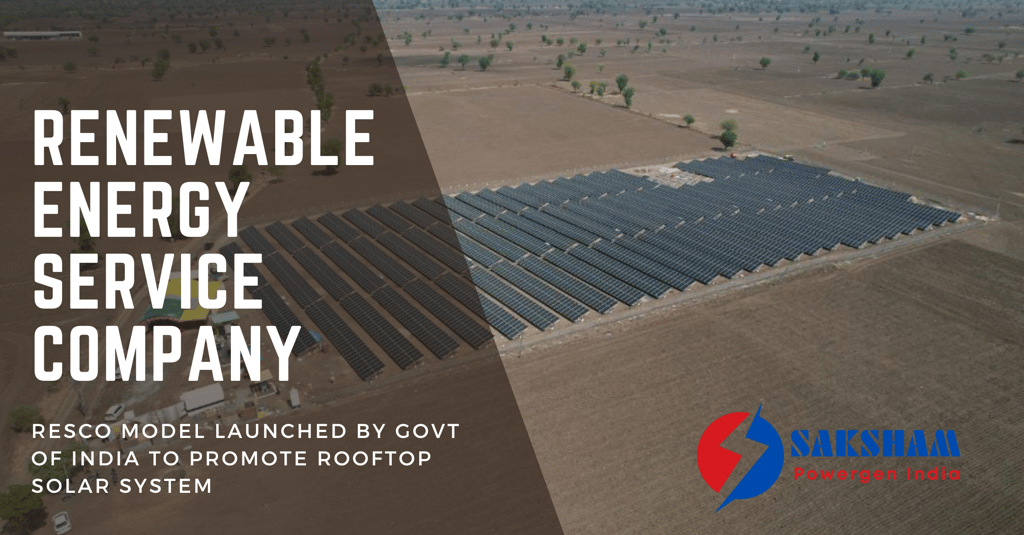Understanding the Renewable Energy Service Company (RESCO) Model in Solar Energy: A Key Initiative by the Government of India
The Government of India has been at the forefront of promoting renewable energy, with solar power playing a pivotal role in its strategy. Among the various models introduced to accelerate solar energy adoption, the Renewable Energy Service Company (RESCO) model has emerged as a game-changing initiative. This model has been specifically designed to make solar energy more accessible, affordable, and scalable across different sectors. Here’s a closer look at the RESCO model and how it is transforming the solar energy landscape in India.
Saksham Power
8/21/20243 min read


What is the RESCO Model?
The Renewable Energy Service Company (RESCO) model is a business model where a third-party service provider installs, owns, and operates a solar energy system on behalf of a client. Under this arrangement, the client does not need to make any upfront investment in the solar infrastructure. Instead, they pay the RESCO for the electricity generated by the system, usually at a rate lower than conventional utility rates. This model is particularly beneficial for entities that want to adopt solar energy but may not have the financial resources or expertise to manage a solar project.
Key Features of the RESCO Model...
Zero Upfront Investment: One of the most significant advantages of the RESCO model is that it eliminates the need for the client to invest in solar panels, inverters, and other related infrastructure. The RESCO takes on the financial burden, making it easier for businesses, institutions, and even residential complexes to switch to solar energy.
Operational and Maintenance Responsibility: The RESCO is responsible for the operation and maintenance (O&M) of the solar energy system throughout the contract period. This ensures that the system is well-maintained and operates at optimal efficiency, without the client having to worry about technical issues or additional costs.
Long-Term Agreement: Typically, the RESCO model involves a long-term power purchase agreement (PPA), often ranging from 10 to 25 years. During this period, the client agrees to purchase electricity generated by the solar system at a fixed or predictably increasing rate, providing long-term cost stability.
Lower Energy Costs: Since the client pays for the electricity generated by the solar system at a rate that is usually lower than traditional electricity tariffs, they can achieve immediate and substantial savings on their energy bills.
Flexibility and Scalability: The RESCO model offers flexibility in terms of project size and scalability. Whether it’s a small rooftop installation or a large ground-mounted solar farm, the RESCO can tailor the solution to meet the specific energy needs of the client.
Government of India’s Support for the RESCO Model...
The Government of India has recognized the potential of the RESCO model in driving the widespread adoption of solar energy. To support this initiative, the government has implemented several policies and incentives, including:
Subsidies and Grants: The government offers various subsidies and grants to RESCOs to reduce the cost of solar installations and make the service more affordable for end-users.
Favorable Policies: Through initiatives like the National Solar Mission and state-specific solar policies, the government has created a favorable regulatory environment for the growth of the RESCO model. These policies include net metering, solar parks, and land allocation for solar projects.
Public Sector Engagement: The government is actively encouraging public sector undertakings (PSUs) and government buildings to adopt the RESCO model. This not only helps in reducing energy costs for government entities but also sets an example for private sector adoption.
Encouraging Rooftop Solar: The RESCO model is particularly well-suited for rooftop solar installations, which the government is keen to promote as part of its goal to achieve 40 GW of rooftop solar capacity by 2022.


Benefits of the RESCO Model...
The RESCO model offers several benefits to different stakeholders:
For Clients (Businesses, Institutions, Residential Societies): The model provides a hassle-free, cost-effective way to switch to solar energy. Clients can enjoy the benefits of solar power without the risks associated with capital investment or system maintenance.
For RESCOs: The model opens up new business opportunities in the growing solar market. RESCOs can generate revenue through long-term PPAs while contributing to the expansion of renewable energy in India.
For the Environment: By making solar energy more accessible and affordable, the RESCO model helps reduce reliance on fossil fuels, leading to lower greenhouse gas emissions and a smaller carbon footprint.
For the Government: The model supports the government’s renewable energy targets and contributes to energy security, reduced dependence on imported fossil fuels, and the achievement of climate goals.
Challenges and the Way Forward...
While the RESCO model is a powerful tool for promoting solar energy, it does come with challenges. These include the need for adequate financing, managing the risks associated with long-term PPAs, and ensuring that RESCOs maintain high standards of system performance and customer service.
To overcome these challenges, ongoing government support, robust financial frameworks, and the development of standardized contracts and best practices are essential. As the market matures, it is expected that the RESCO model will become even more attractive and accessible, driving further growth in India’s solar energy sector.
